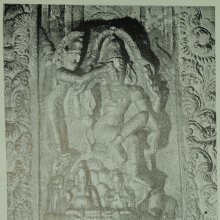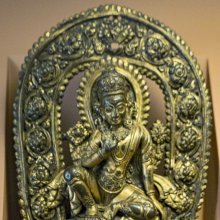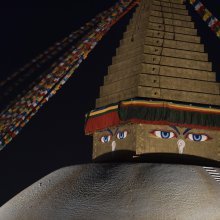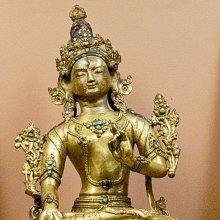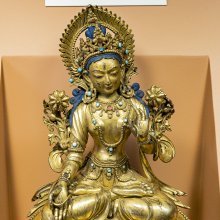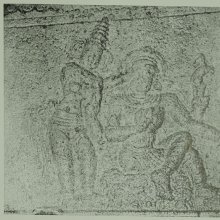Eye, Ēyē: 4 definitions
Introduction:
Eye means something in Hinduism, Sanskrit, biology, Tamil. If you want to know the exact meaning, history, etymology or English translation of this term then check out the descriptions on this page. Add your comment or reference to a book if you want to contribute to this summary article.
Images (photo gallery)
(+66 more images available)
In Hinduism
Natyashastra (theatrics and dramaturgy)
Source: Shodhganga: Elements of Art and Architecture in the Trtiyakhanda of the Visnudharmottarapurana (natya)1) The Eyes refers to one of the minor Body Parts (belonging to the Face) with which are associated various gestures and expressions (in Sanskrit Dramas), as conveyed through Āṅgikābhinaya: one of the four divisions of Abhinaya or “ways to convey or represent one’s emotion to others”, according to the Nāṭyaśāstra and the Viṣṇudharmottarapurāṇa, an ancient Sanskrit text which (being encyclopedic in nature) deals with a variety of cultural topics such as arts, architecture, music, grammar and astronomy.—The āṅgikābhinaya includes the histrionic representation of the limbs which is simply known as physical gestures. The upāṅgas denote different parts of the Face. These are also six in numbers viz., eyes, eyebrows, nose, lower lip, cheeks and chin.
2) The Eyes (of Śakra and Maheśa) are associated with Sūcyāsyahasta: one of the twenty-two Single-hand Gestures (in Indian Dramas) (known as asaṃyuktahastas).—The word sūcī means a tool which is used for stitching. It refers to the needle. [...] The Viṣṇudharmottarapurāṇa says that the natural phenomenon like day and night are denoted with this hand posture. It is also used to denote the eyes of Śakra and Maheśa.

Natyashastra (नाट्यशास्त्र, nāṭyaśāstra) refers to both the ancient Indian tradition (shastra) of performing arts, (natya—theatrics, drama, dance, music), as well as the name of a Sanskrit work dealing with these subjects. It also teaches the rules for composing Dramatic plays (nataka), construction and performance of Theater, and Poetic works (kavya).
Shilpashastra (iconography)
Source: Shodhganga: Elements of Art and Architecture in the Trtiyakhanda of the Visnudharmottarapurana (shilpa)1) The Eyes are denoted by the Sanskrit term Netra, and follows specific guidelines of ancient Indian Painting (citra), according to the Viṣṇudharmottarapurāṇa, an ancient Sanskrit text which (being encyclopedic in nature) deals with a variety of cultural topics such as arts, architecture, music, grammar and astronomy.—Beautiful eyes always enhance the beauty of a person as well as the portrait of a person. A plenty of description of different kinds and shapes of eyes and their charms are found in the writings of different poets of Sanskrit literature. In the Viṣṇudharmottarapurāṇa also, different kinds of eyes and their particular shapes are elaborately discussed in the context of Painting. The measurements of eyes are mentioned here with the unit called yava i.e., a barley corn. In the Līlāvatī of Bhāskarācārya, the reference of this particular unit is found.
2) Eyes are mentioned in a list of body-parts each having their own measurement for the Painting of different portraits of different kinds of men and women, according to the third part of the Viṣṇudharmottarapurāṇa, chapters 35th to 43rd. The measurement of almost all the body parts that should be maintained in a picture have been presented here. For example, the Eye (netra) should be 12 aṅgulas.

Shilpashastra (शिल्पशास्त्र, śilpaśāstra) represents the ancient Indian science (shastra) of creative arts (shilpa) such as sculpture, iconography and painting. Closely related to Vastushastra (architecture), they often share the same literature.
Yoga (school of philosophy)
Source: ORA: Amanaska (king of all yogas): A Critical Edition and Annotated Translation by Jason BirchThe Eyes are denoted by the Sanskrit term Netra, according to the Parākhyatantra verse 14.8-9.—Accordingly, while discussing preliminary practices to make the Yogin ready to undertake the six auxiliaries of Śaiva yoga: “He should adopt one of these [four poses], placing his hands with the palms arranged [facing upwards] in his own lap, expanding his chest evenly. Slightly closing his two eyes (netra), he should focus on the tip of his nose. Remaining thus he is fit for yoga and he should then begin its sequence”.

Yoga is originally considered a branch of Hindu philosophy (astika), but both ancient and modern Yoga combine the physical, mental and spiritual. Yoga teaches various physical techniques also known as āsanas (postures), used for various purposes (eg., meditation, contemplation, relaxation).
Biology (plants and animals)
Source: Google Books: CRC World Dictionary (Regional names)Eye in Nigeria is the name of a plant defined with Pennisetum glaucum in various botanical sources. This page contains potential references in Ayurveda, modern medicine, and other folk traditions or local practices It has the synonym Penicillaria spicata (L.) Willd. (among others).
Example references for further research on medicinal uses or toxicity (see latin names for full list):
· Conspectus Florae Africae (1894)
· Acta Biol. Cracov., Ser. Bot. (1982)
· Naturaliste Canad. (1984)
· Rhodora (1916)
· J. Wuhan Bot. Res. (1985)
· Cytologia (1991)
If you are looking for specific details regarding Eye, for example diet and recipes, health benefits, chemical composition, extract dosage, pregnancy safety, side effects, have a look at these references.

This sections includes definitions from the five kingdoms of living things: Animals, Plants, Fungi, Protists and Monera. It will include both the official binomial nomenclature (scientific names usually in Latin) as well as regional spellings and variants.
See also (Relevant definitions)
Partial matches: E.
Starts with: Eye Consciousness, Eye obale efinrin, Eye-bright, Eye-lotion plant, Eyeball, Eyebright, Eyebrow, Eyec, Eyek, Eyeka la ngeie, Eyelash grass, Eyelel, Eyenal, Eyes plant, Eyesight, Eyeta ngomba, Eyete, Eyeyongo.
Ends with (+41): Agbon-eye, Ajeya, Ayeye, Ayinreye, Bottlebrush buckeye, Buckeye, California buckeye, Californian buckeye, Clear-eye, Closed eye, Creeping oxeye, Daiteye, Deformed eye, Devine Eye, Divine Ear And Eye, Dwarf buckeye, Eemo eye, Eeran eye, Emeye, Ereye.
Full-text (+7524): Cakshus, Nayana, Locana, Akshi, Netra, Ikshana, Nimisa, Vilocana, Cakshushya, Drishti, Divyacakshus, Cakshusha, Apanga, Anjana, Anakshi, Prajnacakshus, Harinakshi, Amsudhala, Nimilana, Jnanacakshus.
Relevant text
Search found 503 books and stories containing Eye, Ēyē, Ē-ē, E-e; (plurals include: Eyes, Ēyēs, ēs, es). You can also click to the full overview containing English textual excerpts. Below are direct links for the most relevant articles:
Impact of Vedic Culture on Society (by Kaushik Acharya)
Methodology < [Chapter 1]
1.A: Dāna in the Vedic Period < [Chapter 2]
The Religion and Philosophy of Tevaram (Thevaram) (by M. A. Dorai Rangaswamy)
Chapter 4.6 - (h) Symbology of Shiva’s eyes < [Volume 2 - Nampi Arurar and Mythology]
Nayanar 10: Kannappa (Kannappar) < [Volume 4.1.1 - A comparative study of the Shaivite saints the Thiruthondathogai]
Nayanar 31: Dandi Adigal (Tantiyatikal) < [Volume 4.1.1 - A comparative study of the Shaivite saints the Thiruthondathogai]
The Great Chronicle of Buddhas (by Ven. Mingun Sayadaw)
The Story of King Sivi < [Chapter 6 - On Pāramitā]
Buddha attributes (3): Vijjācaraṇa sampanno < [Chapter 42 - The Dhamma Ratanā]
Part 10a - The method of fulfilling the Perfection of Generosity (Dāna Pāramī) < [Chapter 7 - On Miscellany]
The Jataka tales [English], Volume 1-6 (by Robert Chalmers)
Jataka 499: Sivi-jātaka < [Volume 4]
Jataka 353: Dhonasākha-jātaka < [Volume 3]
Jataka 473: Mittāmitta-jātaka < [Volume 4]
The Garuda Purana (by Manmatha Nath Dutt)
Chapter CLXXI - The Nidanam of diseases of the eyes < [Dhanvantari Samhita]
Chapter XXXV - The mode of worshipping the Hayagriva manifestation of Vishnu < [Agastya Samhita]
Chapter LXV - Auspicious marks on men and women as disclosed by the science of Samudrikam < [Agastya Samhita]
Sushruta Samhita, Volume 6: Uttara-tantra (by Kaviraj Kunja Lal Bhishagratna)
Chapter VI - Pathology of the diseases affecting the eyes as a whole < [Canto I - Shalakya-tantra (ears, eyes, nose, mouth and throat)]
Chapter I - Diseases of the eye and its appendages < [Canto I - Shalakya-tantra (ears, eyes, nose, mouth and throat)]
Chapter XIX - Treatment of hurt or injnry to the eye < [Canto I - Shalakya-tantra (ears, eyes, nose, mouth and throat)]
Related products
(+147 more products available)
